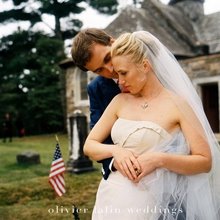Wedding Veils
 An occasion on which a Western woman is likely to wear a veil is on her wedding day, if she follows the traditions of a white wedding. Brides used to wear their hair flowing down their back at their wedding to symbolise their virginity, now the white diaphanous veil is often said to represent this.
An occasion on which a Western woman is likely to wear a veil is on her wedding day, if she follows the traditions of a white wedding. Brides used to wear their hair flowing down their back at their wedding to symbolise their virginity, now the white diaphanous veil is often said to represent this. It is not altogether clear that the wedding veil is a non-religious use of this item, since weddings have almost always had religious underpinnings, especially in the West: in the Christian tradition this is expressed in the Gospel passage, "What therefore God has joined together, let no man put asunder" (Mt. 19:6). Veils, however, had been used in the West for weddings long before this. Roman brides, for instance, wore an intensely flame-colored and fulsome veil, called the flammeum, apparently intended to protect the bride from evil spirits on her wedding day.
It is not altogether clear that the wedding veil is a non-religious use of this item, since weddings have almost always had religious underpinnings, especially in the West: in the Christian tradition this is expressed in the Gospel passage, "What therefore God has joined together, let no man put asunder" (Mt. 19:6). Veils, however, had been used in the West for weddings long before this. Roman brides, for instance, wore an intensely flame-colored and fulsome veil, called the flammeum, apparently intended to protect the bride from evil spirits on her wedding day. The lifting of the veil was often a part of ancient wedding ritual, symbolising the groom taking possession of the wife, either as lover or as property, or the revelation of the bride by her parents to the groom for his approval.
The lifting of the veil was often a part of ancient wedding ritual, symbolising the groom taking possession of the wife, either as lover or as property, or the revelation of the bride by her parents to the groom for his approval.

















